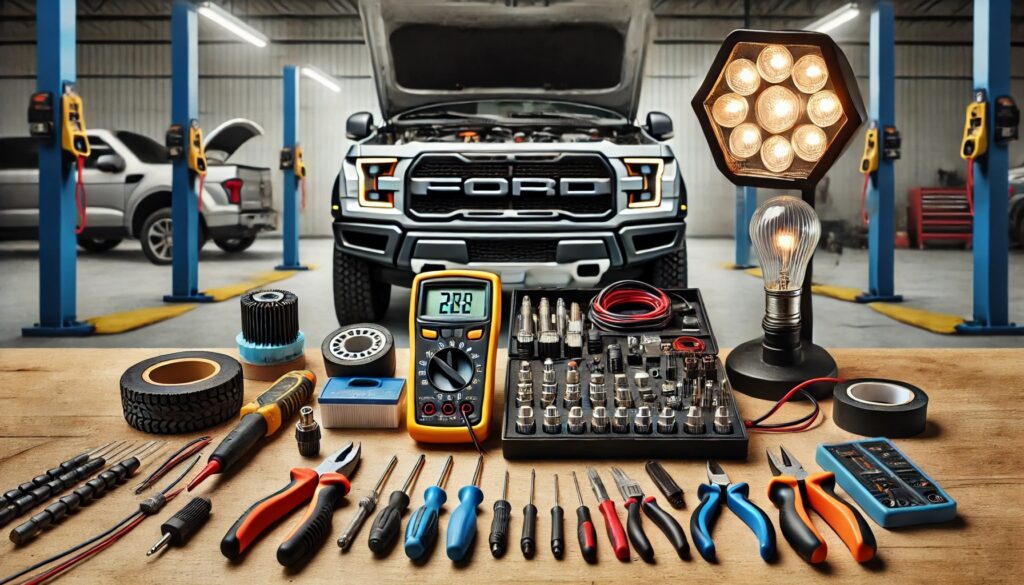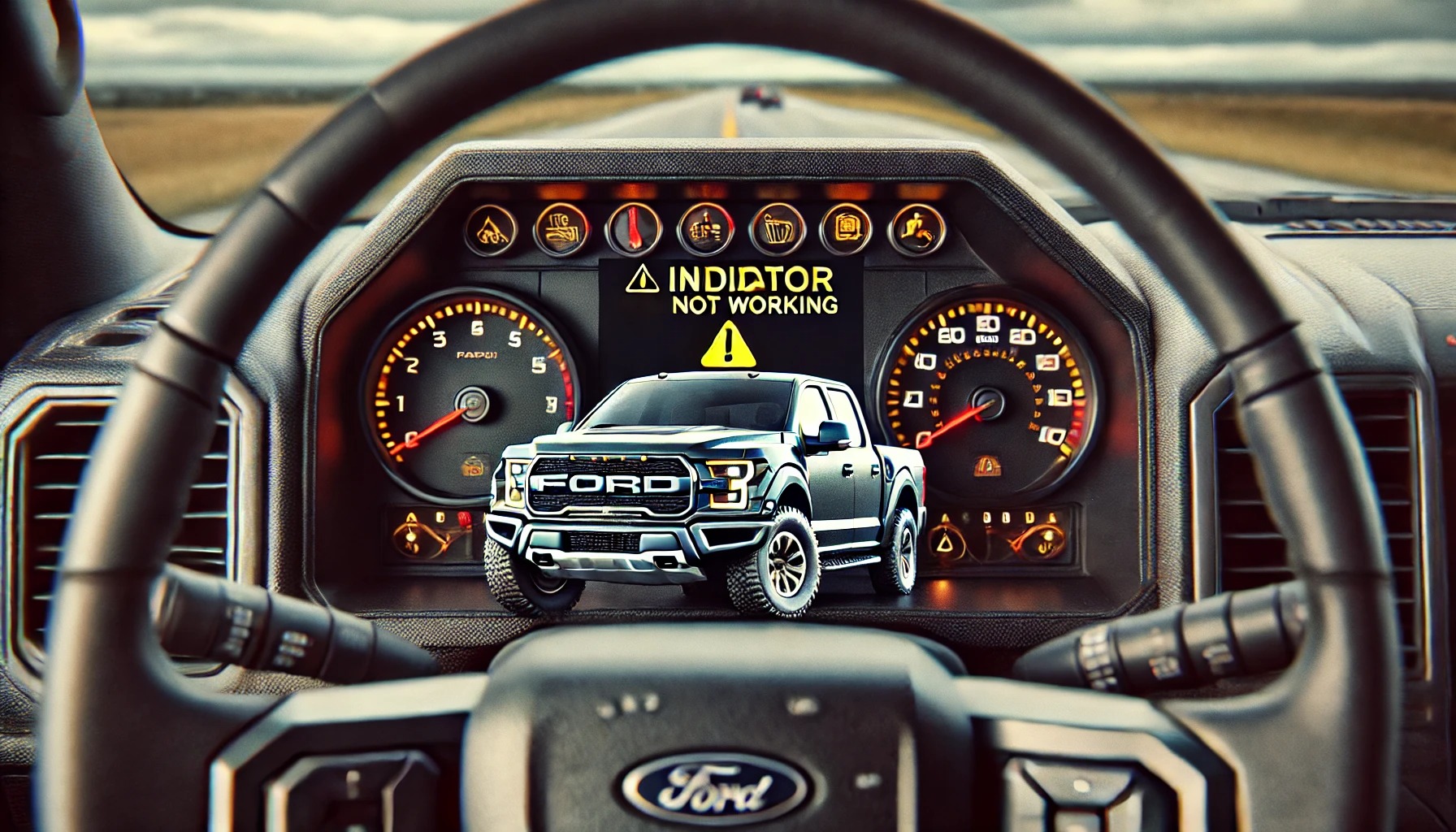From my personal experience, I had an issue where the indicator lights on my 2024 Ford Raptor stopped working, and I found that a blown fuse was the cause. On another occasion, the lights were flashing too quickly, which was due to a burnt-out bulb that I easily replaced. I also faced a situation where heavy rain led to water getting into the light assembly, short-circuiting the system, but I managed to fix it by drying everything out and sealing the lights properly.
If your 2024 Ford Raptor indicator lights are not working, it could be due to issues like blown fuses, burnt-out bulbs, or a faulty turn signal switch. Start by checking the bulbs and fuses, and if the problem persists, inspect the wiring or visit a mechanic. Addressing these issues promptly ensures safety and avoids legal penalties.
Stay tuned with us as we explore the common causes and solutions for “2024 Ford Raptor indicator lights not working.” We’ll provide expert tips on troubleshooting and fixing the issue to keep your vehicle running smoothly. Don’t miss out on helpful advice and step-by-step guides!
Why Aren’t My 2024 Ford Raptor’s Indicator Lights Flashing?
If your 2024 Ford Raptor’s indicator lights aren’t flashing, it could mean:
- The bulbs are burned out: The small light bulbs might need to be replaced.
- The fuse is blown: A tiny electrical safety part (fuse) might have stopped working and needs changing.
- Wiring is loose or damaged: The wires that carry power to the lights might not be connected properly or could be broken.
- The flasher relay is faulty: This is the part that makes the lights blink. If it’s not working, the lights won’t flash.
- The turn signal switch is broken: The lever you move to signal left or right might have a problem.
Check these one by one to find and fix the problem.
What Should I Do If My Indicator Lights Are Flashing Too Quickly?
If your indicator lights are flashing too quickly, here’s what you should do in simple terms:
Check the Bulbs:
The most common reason for fast-flashing indicator lights is a burnt-out bulb. When one bulb is not working, it changes how the electrical circuit operates, causing the others to flash faster. Look at each indicator bulb to see if any are out and replace them if needed.
Inspect the Fuses:
A blown fuse can also cause the indicators to behave strangely. Check your vehicle’s fuse box for any blown fuses related to the turn signals and replace them if necessary.
Look for Loose or Damaged Wires:
Sometimes, the wires that connect to your indicator lights can become loose or damaged. Check these connections to ensure they are secure and not corroded.
Check the Ground Connection:
A poor ground connection can affect how your lights work. Make sure that all ground connections are clean and tight.
Examine the Flasher Relay:
The flasher relay controls how fast the lights blink. If it’s faulty, it may need to be replaced. This is something a mechanic can help you with.
Ensure Proper Voltage Supply:
If your car isn’t getting enough voltage, it can cause the indicators to blink too fast. This might indicate a problem with the vehicle’s electrical system that needs professional attention.
Consult a Mechanic:
If you’ve checked all of these things and your indicators are still flashing too quickly, it’s best to take your vehicle to a mechanic. They can diagnose more complex electrical issues that might be causing the problem.
Can A Software Issue Cause The Indicator Lights To Malfunction?
- Yes, a software issue can sometimes cause the indicator lights to stop working. Modern vehicles, like the 2024 Ford Raptor, use computer systems to control many functions, including the lights.
- If there’s a software glitch or the system needs an update, it might affect how the lights work. For example, the indicators might stop flashing, flash incorrectly, or show warning messages on the dashboard.
- To fix this, visit a Ford dealership or a trusted mechanic. They can check if your vehicle needs a software update or if there’s a bug that needs fixing.
What Does It Mean If Only One Side Of My Indicator Lights Isn’t Working?

If only one side of your indicator lights isn’t working, it usually means there’s a specific problem on that side. Here are some common reasons:
- Burned-out bulb: One of the bulbs on that side (front or back) might not be working. Check both bulbs and replace any that are burned out.
- Wiring issue: The wires carrying power to the lights on that side could be loose, damaged, or disconnected.
- Turn signal switch problem: The lever you use to signal turns might not be sending power correctly to that side.
Start by checking the bulbs first, as that’s the most common and easiest fix! If that doesn’t work, you might need a mechanic to check the wiring or switch.
Is Extreme Weather Likely To Impact My Indicator Lights?
Yes, Extreme weather can impact your indicator lights in a few ways. In cold weather, low temperatures can weaken the battery or cause electrical components to malfunction, which may affect how the lights work. Hot weather, on the other hand, can damage wires, bulbs, or other parts of the electrical system, potentially leading to failures. Rain, snow, or any moisture can seep into the light housing or electrical connections, causing shorts or preventing the lights from functioning properly. Ice buildup can also physically block the indicator lights, while melting snow can let water get inside the light assembly. To avoid these issues, it’s important to keep your vehicle maintained, ensure that seals around the lights are intact, and regularly check for moisture or damage from the weather.
Could A Faulty Turn Signal Stalk Cause My Indicators To Stop Working?
Yes, a faulty turn signal stalk (the lever you use to signal left or right) can cause your indicator lights to stop working. This stalk controls the electrical connection that tells the lights to flash when you signal. If the stalk is broken, worn out, or damaged inside, it might not send the signal to activate the lights properly. In this case, the indicator lights might not work at all or may not flash when you try to use them. If this is the problem, the turn signal stalk may need to be replaced by a mechanic.
Why Does My Dashboard Show A Warning Light For Indicators?
If your dashboard shows a warning light for the indicators, it usually means there’s a problem that needs attention. Here’s a simple breakdown of what it could mean:
Malfunction Detected:
The warning light is there to alert you that the vehicle’s computer has detected an issue with the indicator lights. This could be anything from a burnt-out bulb to a problem with the wiring or the turn signal stalk.
Types of Warning Lights:
- Red Warning Light: If the light is red, it usually indicates a serious problem that requires immediate attention.
- Yellow/Orange Warning Light: If it’s yellow or orange, it means there’s an issue that needs to be checked soon but isn’t as urgent as a red light.
Potential Issues:
Some common reasons for the warning light include:
- A burnt-out bulb on one side.
- A blown fuse affecting the indicator circuit.
- Faulty wiring or connections.
- A malfunction in the turn signal stalk.
What to Do:
If you see this warning light:
- Check your indicator lights to see if they are working properly.
- Inspect the bulbs and fuses.
- If everything looks fine but the light stays on, it’s best to take your vehicle to a mechanic or dealership for further diagnosis.
What Tools Do I Need To Repair Indicator Light Problems On My Ford Raptor?

To repair indicator light problems on your Ford Raptor, you’ll need a few basic tools:
- Multimeter: This tool helps you test electrical parts, like fuses and wires, to make sure they’re working correctly.
- Screwdriver or socket wrench: These tools are used to remove covers or parts to access the bulbs, fuses, or wiring.
- Replacement bulbs and fuses: Keep spare bulbs and fuses that match the ones in your vehicle, in case you need to replace them.
- Pliers or wire cutters: If you need to fix or replace any wires, these tools will help you work with them.
- Electrical tape: If you find any frayed or damaged wires, electrical tape can temporarily fix them until you get a proper repair.
How Do I Troubleshoot An Electrical Issue With My Indicator Lights?
To troubleshoot an electrical issue with your indicator lights, follow these easy steps:
Check the Bulbs
Start by checking the indicator bulbs on both sides. If one is burnt out, it can cause the indicator lights to malfunction. Replace any burnt-out bulbs.
Inspect the Fuses
Locate your vehicle’s fuse box and look for fuses related to the indicator lights. If you see a blown fuse (the metal strip inside will be broken or blackened), replace it with a new one of the same rating.
Examine the Turn Signal Stalk
The stalk is the lever you use to activate your turn signals. If it feels loose or doesn’t click properly, it might be faulty. You may need a mechanic to check or replace it.
Look for Loose or Damaged Wires
Check the wiring that connects to your indicator lights for any signs of damage, corrosion, or loose connections. Secure any loose wires and replace damaged ones.
Test the Flasher Relay
The flasher relay controls how fast your indicator lights blink. If it’s not working, it can cause issues with the lights. You can usually find this in the fuse box or near the steering column.
Check Ground Connections
Make sure that the ground connections for your indicator lights are clean and secure. Poor grounding can prevent the lights from working properly.
Consult Your Vehicle Manual
Your vehicle’s manual may have specific troubleshooting steps or diagrams that can help you locate components related to your indicator lights.
Seek Professional Help
If you’ve checked everything and your indicator lights still aren’t working, it’s best to take your vehicle to a mechanic. They can diagnose more complex electrical issues.
Is It Safe To Drive Without Functioning Indicator Lights?
No, it is not safe to drive without functioning indicator lights. These lights are important because they let other drivers know when you’re turning or changing lanes. Without them, other drivers won’t know your intentions, which increases the risk of accidents. Also, in many places, it’s illegal to drive without working indicator lights, and you could get fined. It’s best to fix the problem before you drive again to stay safe on the road.
Can Water Ingress Cause Indicator Lights To Fail?
Yes, water getting into your indicator lights can cause them to fail. When water enters the light housing or the electrical connections, it can short-circuit the system or cause rust and corrosion. This can stop the lights from working properly. If you notice moisture or fog inside the lights, it’s important to fix the seal or remove the water to prevent damage. Always check for signs of water leakage after heavy rain or driving through puddles.
How Much Does It Cost To Fix Indicator Light Issues?

The cost to fix indicator light issues on your Ford Raptor can vary widely depending on several factors. Here’s a simple breakdown of what you might expect:
Simple Repairs
- Bulb Replacement: If the problem is just a burnt-out bulb, replacing it can be very inexpensive, usually costing around $10 to $30 for the bulb itself.
- Fuse Replacement: If a blown fuse is the issue, replacing it typically costs less than $10.
Moderate Repairs
- Wiring Issues: If there are problems with the wiring or connections, repairs can range from $50 to $150, depending on how extensive the damage is and whether you do it yourself or hire a mechanic.
- Turn Signal Stalk Replacement: If the turn signal stalk (the lever you use to activate the indicators) is faulty, replacing it can cost between $100 and $300, including parts and labor.
Major Repairs
- Flasher Relay Replacement: If the flasher relay needs to be replaced, this can cost around $50 to $100 for parts and labor.
- Water Damage Repairs: If water ingress has caused significant damage to the indicator lights or wiring, repairs could be more expensive, possibly ranging from $200 to $600 or more, depending on what needs to be replaced.
Professional Help
If you take your vehicle to a dealership or a professional mechanic for diagnostics and repairs, labor costs can add significantly to your total bill. Labor rates can range from $75 to $150 per hour.
Total Costs
In total, fixing indicator light issues can cost anywhere from as low as $10 for simple bulb replacements to several hundred dollars for more complex problems involving wiring or component replacements.
FAQs
1. Why aren’t my 2024 Ford Raptor’s indicator lights flashing?
Start by checking if the bulbs are functional. If the bulbs are fine, inspect the fuses, wiring connections, and flasher relay for faults.
2. What should I do if my indicator lights are flashing too quickly?
Fast flashing usually indicates a burnt-out bulb or a problem in the indicator circuit. Check each bulb and replace any that aren’t working.
3. Why does my dashboard show a warning light for indicators?
The warning light signals a problem with the indicator system, such as a burned-out bulb, wiring issue, or faulty flasher relay. Consult your owner’s manual for more details.
4. How do I troubleshoot an electrical issue with my indicator lights?
Inspect the wiring for loose or corroded connections, check all fuses, and test bulbs and relays using a multimeter to identify faulty parts.
5. Is it safe to drive without functioning indicator lights?
No, it is unsafe and illegal in many areas. Without working indicator lights, other drivers can’t see your signals, increasing the risk of accidents.
Conclusion
In conclusion, if your 2024 Ford Raptor’s indicator lights are not working, it could be caused by several common issues, including burned-out bulbs, a blown fuse, faulty wiring, a malfunctioning flasher relay, or a damaged turn signal switch. To fix the problem, start by checking and replacing bulbs or fuses, inspecting the wiring for loose connections, and testing the flasher relay. If the issue persists, the turn signal switch or other electrical components might need professional attention. It’s important to address this issue promptly, as driving without functioning indicator lights is unsafe and illegal in most areas. Regular maintenance and keeping an eye on weather-related damage can help prevent future problems.
